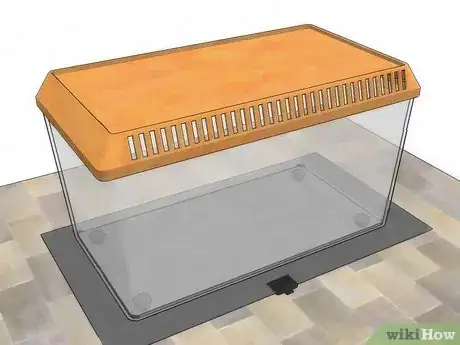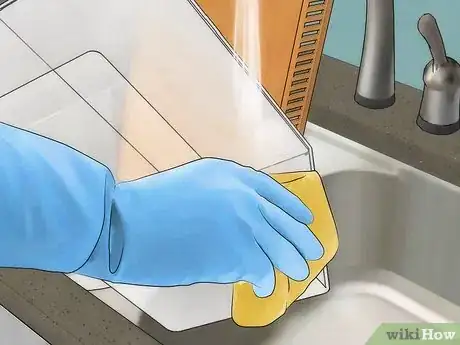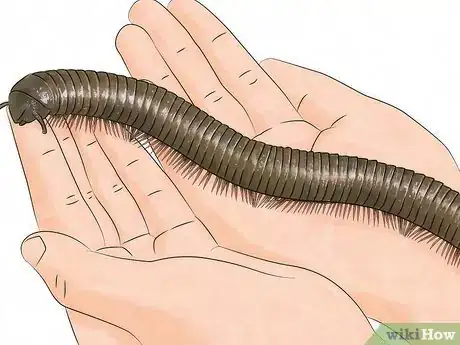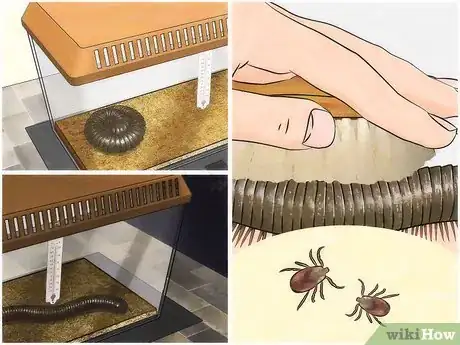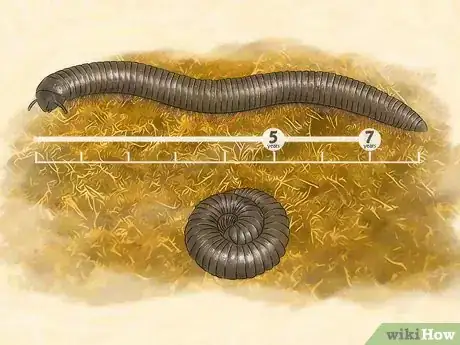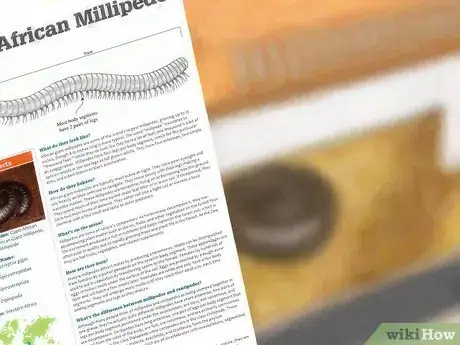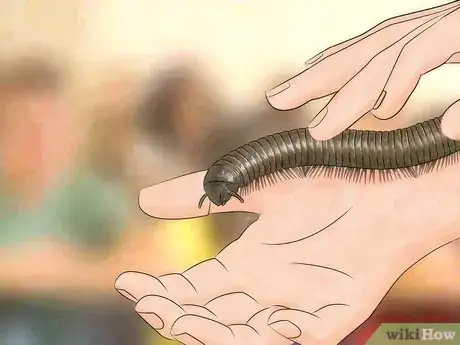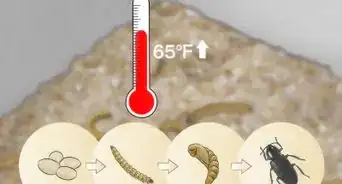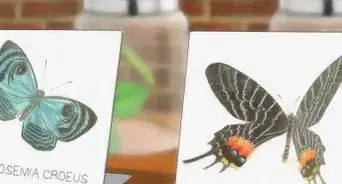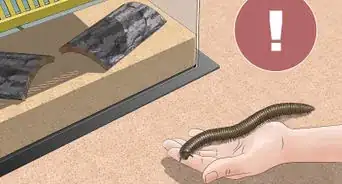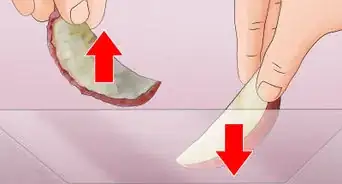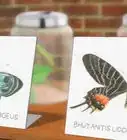This article was co-authored by wikiHow Staff. Our trained team of editors and researchers validate articles for accuracy and comprehensiveness. wikiHow's Content Management Team carefully monitors the work from our editorial staff to ensure that each article is backed by trusted research and meets our high quality standards.
wikiHow marks an article as reader-approved once it receives enough positive feedback. In this case, 87% of readers who voted found the article helpful, earning it our reader-approved status.
This article has been viewed 40,468 times.
Learn more...
Most Giant African Millipedes live either in the wild or in a zoo. They are often a featured attraction in bug exhibits at zoos, because they are large and interesting to observe. It is possible for you to purchase and raise your own Giant African Millipedes. Make sure that you learn how to care for them before bringing them home.
Steps
Housing Your Millipedes
-
1Buy your millipedes. In order to care for your millipedes, you need to purchase them. Most traditional pet stores will not have this species on hand. It is best to search for a reputable online retailer.[1]
- Run an internet search for "purchase Giant African Millipedes". Once you have found some companies that sell them, do your background research.
- Read reviews of current customers. Look for a company that has a satisfied customer base.
- Make sure that the company has experience shipping Giant African Millipedes. You want to make sure that yours arrive safely.
- Giant African Millipedes are legal in the U.S. But if you live with your parents, it's a good idea to ask permission before buying.
-
2Purchase a cage. Head to your local pet supply store to buy a good home for your millipedes. Look for the type of clear plastic or glass tank that houses small pets and reptiles. You want to make sure that it has a lid that has multiple air holes.
- Depending on how many millipedes you have, you will need either a 5 or 10 gallon tank. Millipedes can live comfortably in groups, but they need space to stretch out and move around.
- The cage you purchase should be at least twice as long as your largest millipede. For example, if you have a 12 inch millipede, your cage should be 24 inches long.
- When the millipedes are babies, they can live comfortably in a small plastic container. Just make sure that there are air holes in the lid.
Advertisement -
3Choose the right environment. Once you have the right cage, look around your home to find the best possible location. Millipedes do best when the temperature is about 75-85 degrees Fahrenheit. Consider keeping them in a small room of your house that you can keep warm.
- Make sure that your millipedes do not get too cold. They will not thrive in low temperatures.
- If necessary, you can purchase a heating pad to place under the cage. Ask an employee at the pet store for a recommendation.
- Keep the cage inside your house, not in a garage or in an outdoor garden shed.
-
4Keep the cage clean. Millipedes do not need toys or any decorations for the cage, but they do need a clean environment. Set aside time once a week to clean the cage.[2]
- Remove your millipedes to a temporary home. If you have a backup tank, that is best.
- Remove old food from the cage. Using a paper towel or cloth, wipe up any excrement that is on the floor of the tank.
- Using a mild soap as a cleanser, gently wipe down all surfaces of the tank. Dry with paper towels or a clean cloth.
- Clean more regularly if you have multiple millipedes sharing the same cage.
Meeting the Physical Needs of Your Millipedes
-
1Feed your millipedes. As with any pet, you will need to feed your millipedes a healthy diet. Millipedes are detritivores, which means that they feed off of decaying live matter in their environment. In the wild, this means trees, moss, and other plants.
- You can feed your millipedes a wide variety of produce. Try cucumbers, lettuce, and zucchini.
- Giant African Millipedes will also eat grapes, yams, and apples.
- You can place the produce in the cage and the millipedes will eat it over the course of the day. Just add more food when they are running low.
-
2Provide a moist environment. Make sure that the atmosphere in the cage meets the millipedes' moisture needs. Millipedes thrive in slightly damp soil. Add some soil and some moss to their cage. You can purchase this at gardening stores, and it provides the needed moisture.[3] Purchase an organic soil with no added chemicals.
- You do not need to provide water unless the cage is in a very dry area. If you are concerned, you can soak some cotton wool in water and place that under the soil or moss.
- You can also use a spray bottle to mist water into the cage. Do this every couple of days.
-
3Handle them carefully. You can touch your millipedes, just make sure to be gentle. Pick them up using two hands and hold them lightly. Remember, millipedes can be very long, so you want to support their entire body.[4]
- Millipedes do not sting or bite. They will not harm you.
- If you have children, you can teach them to gently hold the millipedes. This will be a great learning experience.
- Millipedes often curl into a tight ball when scared. If this happens, place them gently back in their home.
-
4Monitor their health. Millipedes are typically sedentary during the day. At night, they generally like to move around their cage and interact with other millipedes. If you notice that your millipede is not moving much, it could be a sign that it is unhealthy.[5]
- Another warning sign to look for is remaining tightly curled. Millipedes curl up when they are scared or threatened. If it doesn't relax, it may not feel well.
- Contact a zoo to ask how to treat an ill millipede. Since they are not native to the U.S., many local vets won't have experience handling them.
Learning About Millipedes
-
1Do your research. Before bringing any pet into your home it is important to learn about the species. Make sure that you are fully prepared to care for your millipedes. Find out how much you are going to spend on supplies and housing and add that into your budget.
- Giant African Millipedes have a typical lifespan of 5-7 years. Take this into account when considering purchasing some. They are not short-term pets.
- You should know that Giant African Millipedes will breed. It is very hard to tell whether you have a male or female, so don't count on preventing breeding. Be prepared to buy additional cages if breeding occurs.
-
2Ask questions. Talk to an expert before deciding to raise Giant African Millipedes. Ask your local veterinarian if he has any experience with the species. Your local zoo can also be a resource.
- Contact the zoo nearest you and ask if they can provide you with information on Giant African Millipedes. You can also take a field trip to visit the bug exhibit at the zoo.
- Ask for additional tips about housing and feeding.
-
3Teach others about millipedes. If you find that you have a passion for raising Giant African Millipedes, you can find ways to share your knowledge. If you are a student, ask your science teacher if you can bring your pets in to show your class. They are really interesting to observe.
- Join an online message board. You can talk to other millipede owners about their ideas and experiences.
Community Q&A
-
QuestionAre they dangerous? In what way?No. They don't sting or bite. Millipedes are completely harmless,which makes them a great pet!
-
QuestionHow do I know if the millipede is dead?
 Community AnswerIf it's not moving, it is likely dead. You can try poking it gently. If it still doesn't move, it's definitely dead.
Community AnswerIf it's not moving, it is likely dead. You can try poking it gently. If it still doesn't move, it's definitely dead. -
QuestionHow do I know the difference between a millipede and a centipede?
 Community AnswerA millipede is more round and a bit taller. A centipede is more flat and short.
Community AnswerA millipede is more round and a bit taller. A centipede is more flat and short.
References
- ↑ http://www.keepinginsects.com/cockroaches-locusts-ants/millipedes/
- ↑ http://animals.sandiegozoo.org/animals/giant-african-millipede
- ↑ http://www.amentsoc.org/insects/caresheets/millipedes.html
- ↑ http://www.oregonzoo.org/discover/animals/giant-african-millipede
- ↑ http://www.keepinginsects.com/cockroaches-locusts-ants/millipedes/
About This Article
To care for your Giant African Millipede, make sure its cage is placed in a warm room of your house so it can stay between 75 to 85 degrees Fahrenheit. Millipedes will not thrive in low temperatures, so consider placing a heating pad under the cage if you can’t find a warm enough spot. Your millipede will also need slightly damp soil, so add organic soil and moss to the cage and mist it every couple of days with a spray bottle of water. Once you have a nice environment for you millipede, you’ll also need to feed it a healthy diet of produce like cucumbers, lettuce, grapes, yams, and apples. It will feed throughout the day, so just add more food when you notice its supply is getting low. For more tips, like how to handle your millipede carefully, scroll down!

